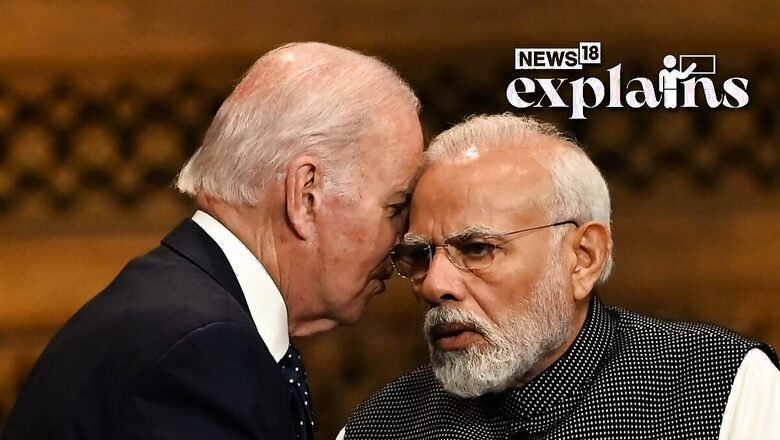
views
Prime Minister Narendra Modi will be embarking on a visit to the United States and Egypt from June 20 to 25. The visit to the US is taking place at the invitation of US President Joseph Biden and First Lady Jill Biden.
The world is eagerly awaiting a new era of partnership between the oldest and largest democracies with Modi’s highly anticipated four-day state visit to the United States. The leader will be joining an exclusive league that includes names like Winston Churchill and Nelson Mandela, who have twice addressed a joint meeting of the US Congress.
What is the Visit’s Schedule?
The visit will commence in New York, where Modi will lead the celebrations of the International Day of Yoga at the UN headquarters on June 21. This day was designated by the UN General Assembly in December 2014.
Following that, Modi will travel to Washington D.C., where he will receive a ceremonial welcome at the White House on June 22 and hold discussions with President Biden as part of their ongoing high-level dialogue. A state dinner will be hosted by the Bidens in honor of the Prime Minister on the same evening.
Modi has also been invited to address a joint sitting of the US Congress on June 22 by Congressional leaders, including Republican House of Representatives Kevin McCarthy and Democratic Senate Speaker Charles Schumer. The following day, he will attend a luncheon hosted jointly by Vice President Kamala Harris and Secretary of State Antony Blinken.
Alongside the official engagements, Modi is scheduled to have interactions with CEOs, professionals, and other stakeholders, as well as meeting with the Indian diaspora.
After concluding his visit to the US, the Prime Minister will proceed to Egypt for a state visit from June 24 to 25.
Why is the Visit Significant?
Before the visit, External Affairs Minister S Jaishankar said PM Modi’s visit to the US will have “significant outcomes.”
“The prime minister is going on a State Visit, which signifies the highest level of honour. So, the honour that he will receive, has been accorded to a very few people, so far,” Jaishankar said at the sidelines of an event.
“The prime minister will address a Joint Session of the US Congress. No Indian prime minister has addressed it twice. So, it will be the first time. World over also, very few people have done that… Winston Churchill, Nelson Mandela. So, there are very few people who have addressed the US Congress twice,” Jaishankar said.
It assumes “huge importance” and outcomes will be seen later, the external affairs minister said. Asked about the implications of the State Visit on India-US relations, he said this State Visit will have “significant outcomes” and added that “what outcomes these will be, I cannot tell that right now”.
Asked what message will this State Visit by Modi to the US send to China and Pakistan, the Union minister said, “When a prime minister visits a country, it is to take our (India’s) relationship forward. I understand that it is a globalised world, so if something happens, it may or may not have an impact on others. We see it for our interests, from perspective of our relations”.
‘Modi-Biden talks to touch 5 areas of significance’
Prime Minister Narendra Modi and US President Joe Biden during their talks next week are expected to touch on five broad areas of significance “healthcare, technology, renewable energy, education and defence” which would be reflected in the joint statement, India’s envoy to the US has said earlier.
“The leadership will touch five broad areas which are significant. They will be touched by the leadership, and they will be reflected in the joint statement which will come out,” Sandhu told PTI in an exclusive interview on Friday.
“Technology is going to be a significant part and you know that technology is cross-cutting. Technology is not only a commercial aspect but also has a very strong strategic side. And trust and confidence are important bases of any technology sharing or collaboration,” he said.
“One is healthcare and in that affordable healthcare, affordable medicines, affordable vaccines, and of course training, research, et cetera, all will be part of it. Number two is on the technology side, it is IT, digital startup innovation. All of them are in one basket.
“Then of course we have another that is the renewable basket, which has solar as an important element of that battery technology, similarly, hydrogen. All these will be prominently there,” Sandhu said in response to a question.
On education and knowledge partnership there is a lot of movement, he said.
“In India, we have a new education policy. Of course, here I would like to mention that there are at present 200,000 Indian students (in the US). Two-thirds of them are in STEM areas. This student population this linkage is a very important linkage. But under the new education policy now the forward movement is going to be in establishing campus-to-campus relations, intertwining of degrees, joint research, work,” Sandhu said.
He said he has personally spoken to a large number of chancellors and presidents of universities and educational institutions.
“You have already seen that this has been carried forward. It’s one of the important elements of iCET that is the education collaboration and that will be a significant path,” he said.
“Finally, not the last and the least is the defence and the strategic side. As I mentioned, high tech is an important element. It is a cross-cutting area. High tech certainly has an impact,” he said.
On the defence side, the United States is a technology powerhouse and India is an emerging technology powerhouse. So, this collaboration interaction is natural, Sandhu said.
“Earlier it was more of a buyer-seller, more of a trading relationship. Now we are looking more deeper to the next level, which is co-production and co-development collaboration between the two sides,” he said.
The relationship is now going to the next level and there are a number of aspects in the visit which are pointing towards that, Sandhu said.
“Even on the ceremonial side to have the state visit. It shows that India has a special respect here and that’s one of the underlying reasons. It’ll also provide an opportunity to both the leaders to be able to spend time together and discuss across the board a number of issues which are of mutual interest,” he said.
“You will see across the areas there is going to be much more cooperation and working together, and this will have an impact not only for the United States and India but also for many third countries,” Sandhu said.
Responding to a question on the India-US collaboration for the global common good, Sandhu said that both the leaders have a very strong comfort factor with each other and in the time, they spend, they will discuss a number of cross-cutting issues.
“But there are some areas in which collaboration is beginning and there is a great push to further it,” he said.
In the healthcare sector, he said, the United States and India can partner together. There is a vaccine called Corbevax, for example, developed by Baylor College, but bulk produced by BioE, an Indian biotechnology and biopharmaceutical company.
“Similarly in IT digital startups, there is again a lot of scope for us to be working together in third countries. Even in education and knowledge partnerships, India has a unique perspective on Africa. We have been present there for years and in so many other areas. That’s another remarkable area where the United States, India partnership can reach for global good as the Prime Minister mentions it,” Sandhu said.
PTI contributed to this report




















Comments
0 comment